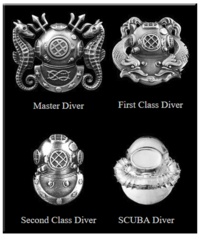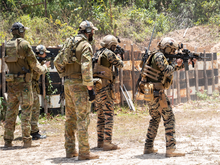| Philippine Naval Special Operations Command (NAVSOCOM) | |
|---|---|
 NAVSOCOM Insignia NAVSOCOM Insignia | |
| Active | November 5, 1956 - Present |
| Country | Philippines |
| Branch | Philippine Navy |
| Type | Special Operations Forces |
| Part of | AFP Special Operations Command (SOCOM) |
| Garrison/HQ | Naval Base Heracleo Alano (Naval Base Cavite) |
| Nickname(s) | SWG, SWAG |
| Mascot(s) | Shark |
| Anniversaries | November 5 |
| Engagements |
|
| Decorations | Philippine Republic Presidential Unit Citation Badge Presidential Streamer Award |
| Commanders | |
| Current commander | COMMO DWIGHT STEVEN M DULNOAN PN |
| Notable commanders | COMMO AP TUMANDA JR PN-NAVSOCOM CAPT DSM DULNOAN PN-NAVSOG CAPT AVP ABAYON PN-NAVSOG CAPT AP TUMANDA JR PN(COMMO)-NAVSOG CAPT RB FAJARDO JR PN(COMMO-RET)-NAVSOG CAPT RJ GALANG PN(RADM-RET)-NAVSOG CDR EC RAMOS PN-NAVSOG CDR RP DAVID PN(RADM)-NAVSOG CDR SZ FELIX PN(RADM-RET)-NSWG LCDR RM SARMIENTO JR. PN-NSWG CAPT PR ACACIO PN-NSWG CDR RF NAPILIAN PN-SWG CAPT JL ADVINCULA PN-SWG LCDR PI FILIO PN-SWG CDR RS REYES PN-SWG LCDR BM GEMPIS PN-UOU LCDR LG DEL MUNDO PN-UOU LTJG RV NAVARRO PN-UOT-UOU LTJG RN BALUYOT PN-UOT |
| Insignia | |
| US-RP Navy SEAL Team Badges |  |
| Naval SCUBA Diver Badges |  |
| RP-US Airborne Badges |  |
| EOD Badges |  |
The Naval Special Operations Command (NAVSOCOM) is a separate command of the Philippine Navy trained in special operations, sabotage, psychological and unconventional warfare and is heavily influenced by the United States Navy SEALs. NAVSOCOM is headquartered at Naval Base Heracleo Alano Sangley Point, Cavite City. It has eleven units located across the Philippines, from Naval Operating Base San Vicente at Santa Ana, Cagayan in the north to Naval Station Zamboanga in the south.
The unit's tasks were also expanded to cover all facets of unconventional warfare in a maritime and riverine environment. This includes but is not limited to demolition, hostage rescue, harassment, force protection and maritime tactical operations.
History
The predecessor unit to the NAVSOCOM, the Underwater Operations Team or UOT was activated on 5 November 1956 as a special operations unit of the Philippine Navy. Patterned after the US Navy Underwater Demolition Teams and the Italian Decima Flottiglia MAS with modifications for Philippine conditions, from its founding the UOT was charged with conducting underwater operations in waterways, beach areas and harbors in support of Philippine naval operations. These operations included underwater explosive disposal, mine countermeasures, salvage and search and rescue. In 1959, the UOT was expanded and redesignated the Underwater Operations Unit (UOU), then as the Underwater Operations Group (UOG).
The UOG was then renamed Special Warfare Group (SWG) in 1983, then Naval Special Warfare Group (NSWG), and later on as the Naval Special Operations Group (NAVSOG) on May 30, 2005.
On 7 July 2020, the unit became the Naval Special Operations Command (NAVSOCOM) when it was separated from the Philippine Fleet. Among the changes included the name change from the Naval Diving Unit (NDU) to the Naval Diving Group (NDG).
On August 20, 2022, the Philippine Navy made NAVSOCOM a regular combat support command with Commodore Alfonspin Tumanda Jr as the commanding officer, taking over from Captain Dwight Steven Dulnoan.
On June 19, 2024, a NAVSOCOM commando lost his thumb during fights with Chinese Coast Guard officers after their ships conducted an interception operation at the Second Thomas Shoal.
Role
The unit specializes in Sea, Air, Land (SEAL) operations ranging from reconnaissance, close combat, demolition, intelligence and underwater operations in support of overall naval operations. The unit gained prominence in a number of counter-terrorism operations, most notably against the Abu Sayyaf Group, and is known for its highly-demanding physical training program which is based on the United States Navy SEAL program.
Training
The NAVSOCOM training program is known as Basic Naval Special Operations Course (BNSOC). The program is physically and mentally demanding and is regarded as one of the toughest military selection programs around the world. Candidates have to swim 3 kilometers and run 10 kilometers every day. Furthermore, they must swim 14.6 nautical miles from Roxas Boulevard in Manila to Sangley Point, Cavite City without any rest. They also undergo "Hell Week", considered as the most demanding week of BNSOC training. Candidates have to carry out demanding physical team events with their boat crews without any sleep at all for an entire week. In one BNSOC class, only 21 students remained from 79 applicants who originally started the BNSOC training program. These are only the common and basic training phases of BNSOC, with further evolutions of the training (including interrogation resistance) remaining highly classified.
Under Filipino law, women can apply to become SEALs, but thus far none have. Prospective SEALS are put through BUD/S, which lasts for four months and can often stretch into six with breaks between phases.
United States influence
There are similarities between the Philippines Naval Special Operations Command and the U.S. Naval Special Warfare Command. NAVSOCOM operators are trained and operate in a manner similar to the U.S. Navy SEALs. They also wear a trident similar to their U.S. Navy counterparts.

The Filipino counterpart of the U.S. counterterrorist United States Naval Special Warfare Development Group (DEVGRU) is the Philippine Naval Special Reaction Group (SRG), which operates under the direction of Naval Intelligence.

They frequently train with their American counterparts and operate alongside the Philippine Marines and the Philippine Army's Special Operations Command (SOCOM).
Units
NAVSOCOM is composed of the following units as of 2020:
Type Groups
- Headquarters, NAVSOCOM
- SEAL Group (SEALG)
- Special Boat Group (SBG)
- Naval Diving Group (NDG)
- Naval Explosive Ordnance Disposal Group (NEODG)
- Combat Service Support Group (CSSG)
- NAVSPECOPNS Training and Doctrine Center (NSOTDC)
Naval Special Operations Units (NAVSOUs)
Each unit is made up of 3 to 6 special operations and support teams, each of which have 8 sailors (1 officer, 7 enlisted).
- Naval Special Operations Unit 1
- Naval Special Operations Unit 2
- Naval Special Operations Unit 3
- Naval Special Operations Unit 4
- Naval Special Operations Unit 5
- Naval Special Operations Unit 6
- Naval Special Operations Unit 7
- Naval Special Operations Unit 8
- Naval Special Operations Unit 9
- Naval Special Operations Unit 10
- Naval Special Operations Unit 11
Equipment
NAVSOCOM is known to use the HK416, M4 assault rifles, M60E5/E6 GPMG and M110A2 sniper rifle and night vision PVS-14s and PVS-31s, while some SEALs have been seen with Elbit Systems XACT NVGs.
10 fast boats were acquired by the unit in December 2020.
References
- ^ https://navy.mil.ph/downloads/1644813486-ROUGH%20DECK%20LOG%20DECEMBER%202021%20ISSUE.pdf
- ^ "Gapay cites Navy, military for job well done in farewell visit". Philippine News Agency. Retrieved 4 February 2021.
- "AFP chief vows more support for elite naval group". www.pna.gov.ph.
- Military balance : the annual assessment of global military capabilities and defence economics 2017. Arundel House, Temple Place, London, UK: Routledge, Taylor & Francis for The International Institute for Strategic Studies. 2017. ISBN 978-1857439007. OCLC 960838207.
- ^ Conboy (1991), p. 46.
- "NAVSOG | Careers". navsog.navy.mil.ph. Archived from the original on 19 March 2014. Retrieved 11 January 2022.
- "PH Navy activates command of elite naval troops". Manila Bulletin.
- "Philippines accuses Chinese coast guard of boarding navy boats in South China Sea". 19 June 2024.
- Manalo, Eusaquito P. (2004). The Philippine Response to Terrorism: The Abu Sayyaf Group. Storming Media. ISBN 9781423521877.
- "NAVSOG: The past, present, and future of the Philippine Navy SEALs". SOFREP. 18 May 2017.
- "Special Warfare Group (SWAG)". ShadowSpear. 29 January 2009. Retrieved 11 May 2015.
- "Smoking-cessation classes, counseling among options offered on U.S. bases in Pacific". Stars and Stripes. Retrieved 11 May 2015.
- "CARAT 2004: Philippine and U.S. Forces Train to Fight Terrorism" - Asia-Pacific Defense Forum, Winter 2005
- "NAVSOG - Organization". Archived from the original on 2014-03-19. Retrieved 11 May 2015.
- "Bacarro is now a Navy SEAL". Manila Bulletin.
- "PH Navy upgrades make waves amid pandemic". www.pna.gov.ph.
Bibliography
- Conboy, Kenneth (1991). South-East Asian Special Forces. Osprey Publishing. ISBN 978-1855321069.
External links
- Official Website at the Wayback Machine (archived 2014-03-19)
- Basic Naval Special Operations Course (BNSOC) News Report